Guide to garden power tools
Guide to garden power tools
Introduction
Keeping a garden looking its best is a breeze with the right garden power tools. But, with so many to choose from, how do you know which ones are right for your needs?
This guide tells you everything you need to know about three of the most used garden power tools: lawn mowers, grass trimmers and hedge trimmers.
It covers how lawn mowers work, the different types, and what to look for when buying a lawn mower. In addition, we look at grass trimmer and hedge trimmer features and highlight some things to consider when buying these garden power tools.
Finally, we give tips on the maintenance, cleaning and storage of garden power tools and answer your frequently asked questions.
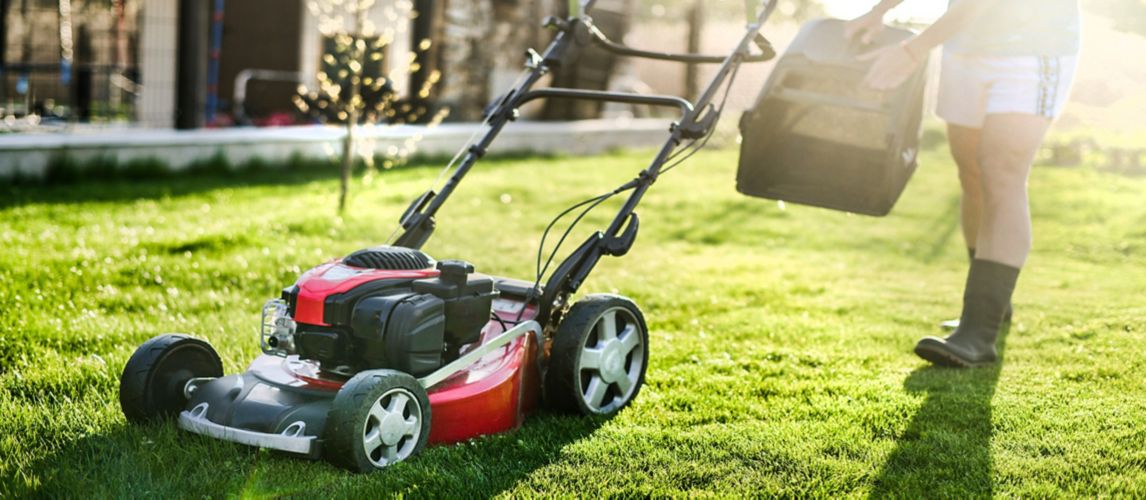
Best Garden Power Tools
Grass and hedge trimming are the most routinely carried out tasks in a garden. So, no gardener’s tool kit or homeowner’s shed is complete without a lawn mower, garden trimmer or hedge trimmer.

Lawn mowers are the most essential power tool for maintaining a healthy and tidy looking lawn. Cutting the grass regularly during the growing season encourages it to grow thick and makes it look luscious.
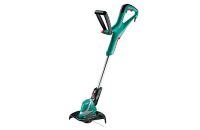
Grass trimmers are perfect for keeping weeds and long grass under control. They’re also useful for trimming grass that a mower can’t reach around borders and edges.
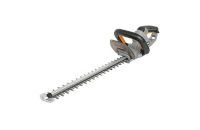
Hedge trimmers are ideal for keeping hedges trimmed back to avoid encroaching on garden space or pathways, and trimmed hedges look neat too.
How Lawn Mowers Work
Lawn mowers come in many types, shapes and sizes, but they have the same two key components:
- The deck is the part of the mower that’s close to the ground and contains the cutting blade. On a rotary mower, the blade is a disc that rotates horizontally. A cylinder mower has several blades formed into a cylinder shape.
- The engine can be either electric or petrol powered. If it’s petrol powered, there will also be a fuel tank. If it’s a cordless electric mower, there will also be a battery. The only lawn mowers without an engine are cylinder lawn mowers.
In addition to these two parts, lawn mowers will all have a handle to push it with. There will be some kind of start mechanism (excludes cylinder mowers) – whether that’s a push button or a pull cord on some petrol models. Most lawn mowers have wheels, and some have a grass collection box.
Lawn mowers can also be self-propelled (SP) or hand-propelled (HP). Self-propelled mowers have a built-in drive that pushes the mower forward without having to push it. So, less effort is needed because all you have to do is steer. This is ideal for large gardens and gardens with a slope. Hand-propelled lawn mowers must be pushed to make them move, so they’re better for smaller, flat lawns.
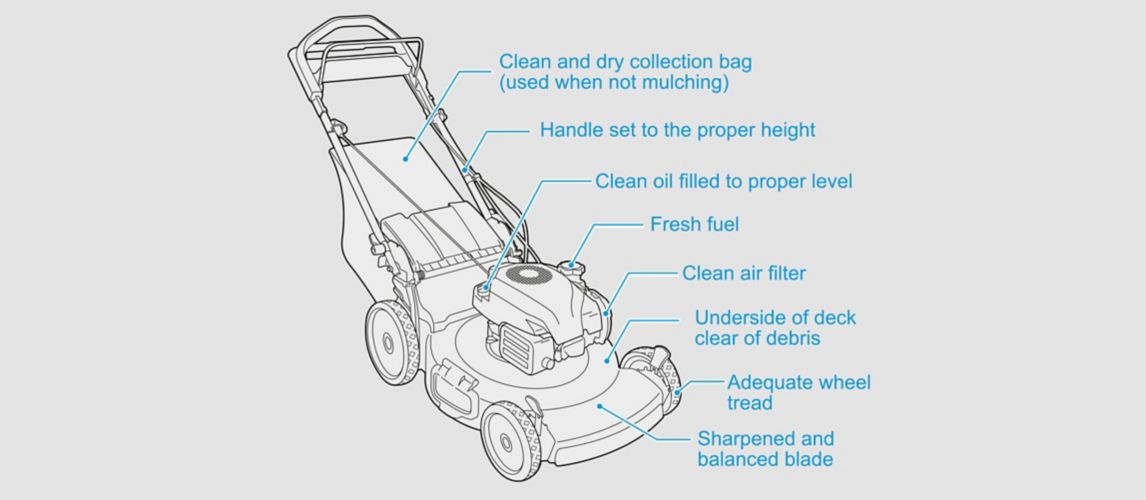
How to Choose the Best Lawn Mower for Your Lawn
Deciding which lawn mower to buy depends on the garden’s size. There are three things to consider:
- Cutting width -The wider it is, the more grass it will cut, reducing the time the job takes. However, bear in mind that lawn mowers with large cutting widths are heavier, bulkier and harder to manoeuvre around corners and obstacles. So, a large cutting width isn’t ideal for small lawns.
- Mower type - Electric mowers are best suited to lawns up to 700m2, while petrol or ride-on mowers are best for much larger gardens.
- Power - Generally, the larger the lawn and mower cutting width, the more power you’ll need. Power on electric mowers is measured in watts (W). Cordless mowers with a lithium-ion battery measure power in volts (V). They also have an amp hour (Ah) rating, which tells you how long the battery lasts. Petrol mowers are measured on engine capacity (cc). The higher the capacity, the lower the effort the engine will output for the same performance.
Use the table below as a guide to help you determine which lawn mower is best for your needs:
|
CUTTING WIDTH |
MOWER TYPE |
POWER | |
|---|---|---|---|
|
Lawn size | |||
|
Small - Up to 100m2 |
Up to 32cm |
Cylinder Electric - Corded |
Cylinder - manual Corded: 1000-1300W Cordless/robotic: 18V – 2Ah |
|
Medium - 100-400m2 |
32-40cm |
Electric - Corded |
Corded: 1000-1300W Cordless/robotic: 18V – 2Ah |
|
Large - 400-700m2 |
40cm+ |
Electric - Corded |
Corded: 1400-1800W Cordless/robotic: 36V – 3Ah |
|
Very large - 700-6000m2 |
48cm+ |
Petrol Ride on |
Petrol: - Up to 900m2: 100cc Ride on: 190cc |
|
Extra large - 6000m2+ |
107cm+ |
Ride on |
500cc |
Types of Lawn Mower
Several types of lawn mowers are available, each with advantages and disadvantages. This section looks at the different kinds of lawn mowers and their pros and cons.

Rotary lawn mowers explained
Rotary lawn mowers have a single, easy to maintain blade that rotates underneath the machine horizontally to cut the grass. They come as hand-propelled (meaning the mower has to be pushed to make it move) or self-propelled (where the mower has a built-in driver that drives it forward).
Hand-propelled rotary mower pros:
- Copes well with most types of grass and terrain
- Easily mows over leaves and twigs
- Wide range available in all power sources and power ratings
Hand-propelled rotary mower cons:
- Noisy
- Hard work to push the mower over long grass, rough terrain or slopes
- Takes longer to cut the grass than self-propelled mowers
Self-propelled rotary mower pros:
- Copes well with most types of grass and terrain
- Makes mowing on slopes easier
- Easily mows over leaves and twigs
- Wide range available in all power sources and power ratings
- Mowing takes less effort and is quicker than using a hand-propelled rotary mower
Self-propelled rotary mower cons:
- Noisy
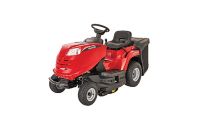
Ride-on lawn mowers explained
Ride-on lawn mowers are ideal for very large gardens or commercial spaces. Most models are petrol, but some have electric, battery powered motors.
Ride-on mower pros:
- Efficient – saving time and energy
- Smaller models can fit through gaps in hedges or gateways to make it easier to manoeuvre
- Light steering provides quick movement around complex areas
- Can get close to borders and trees
- Added features include automatic blade shut off, ensuring driver safety if the user dismounts while the machine is running.
Ride-on mower cons:
- Needs to be serviced by a professional annually
- Ongoing fuel costs for petrol models
- Needs a large space to store it
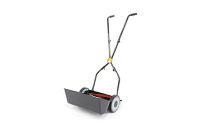
Cylinder lawn mowers explained
Cylinder lawn mowers (also called push mowers) use blades that rotate on a cylinder to trap and slice grass. They don’t have an engine, so they are operated by manually pushing them. They’re designed for frequent cutting of short, fine, manicured grass.
Cylinder lawn mower pros:
- Low maintenance
- Eco-friendly
- Cost-effective
- Leaves a manicured finish on even lawns
- Easy to use
- No cables, charging batteries or petrol filling required
- Quiet
Cylinder lawn mower cons:
- Don’t cope with long grass or bumpy terrain
- Can be hard work to physically push the mower.
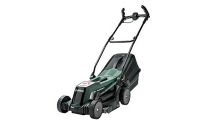
Wheel lawn mowers explained
Wheel lawn mowers are lawn mowers that have four wheels.
Wheel lawn mower pros:
- Fixed wheels make cutting in straight lines easy
- The wheels take the weight of the mower, making it easier to move
- Multiple cutting heights allow cutting for different lengths of grass
- Copes well with most types of grass and terrain
- Easily mows over leaves and twigs
- Wide range available in all power sources and power ratings
Wheeled lawn mower cons:
- Fixed wheels make it hard to manoeuvre around corners and bends
- The wheels can restrict how close you can cut to the edges
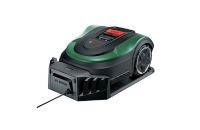
Robotic lawn mowers explained
Robotic lawn mowers cut grass independently without being pushed or driven. They’re battery powered and sit within a charging station. You simply pre-set them to work automatically on a schedule. They will cut the grass then return to their charging station. Some must be set up using boundary wires to ensure they only cut where you want them to. Others use beacon technology to recognise boundaries and obstacles. There are also smart robotic lawn mowers that can connect to and be controlled by an app on a smartphone or tablet through Wi-Fi. You’ll need to ensure there’s a strong enough Wi-Fi signal in the garden to use these, but you can buy Wi-Fi-extenders to help with this if necessary.
Robotic lawn mower pros:
- Saves time
- Releases mulched grass clippings back to the ground, leaving a healthier lawn
- Pre-programmed to start at specific times
- Re-charges on its own
- Smart robotic lawn mowers can be controlled using a smartphone
Robotic lawn mower cons:
- More expensive than other mowers
- Installing the boundary wires can be difficult
- Can be at risk from garden thieves
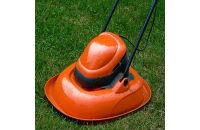
Hover lawn mowers explained
Hover lawn mowers are rotary mowers that don’t have wheels. Instead, they glide over the grass on a cushion of air which raises them slightly off the ground. They’re designed to be used on short, regularly cut grass and come with or without a grass collection box.
Hover lawn mower pros:
- Light and easy to manoeuvre
- Models without a collection box can be moved from side-to-side, not just forwards and backwards
- Ideal for uneven lawns, slopes and irregularly shaped gardens
- Compact models without a grass collection box can be hung on a wall for storage
Hover lawn mower cons:
- Don’t cope well with long and damp grass
- Don’t always cut very neatly
Lawn Mowers by Fuel Type
Apart from hand-pushed cylinder mowers, lawn mowers are powered by electricity or petrol. As a guide, electric lawn mowers are suitable for small and medium to large lawns up to 700m2, and petrol mowers are best suited for any lawn bigger than that.
This section looks at petrol and electric lawn mowers in more detail and highlights their pros and cons.
Petrol lawn mowers explained
Petrol lawn mowers are perfect for tackling larger lawns and provide a cord-free solution. Their engines are measured in cubic capacity (cc) – the higher the cubic capacity, the more power they have. In addition, they have a petrol tank with a capacity measured in litres. A bigger tank means you can mow for longer before having to stop and fill it up, although a large cc engine will burn fuel quicker than a small cc engine.
Petrol lawn mower pros:
- More powerful than electric motors, making them suitable for thick or overgrown grass
- Suitable for bumpy and sloping ground
- No restrictive cable
- Keeps going longer than battery-powered mowers
Petrol lawn mower cons:
- Heavier than electric mowers
- Very noisy
- Ongoing fuel costs
- Needs regular maintenance and servicing
- Can be difficult to start (particularly models with a pull-cord start)
Produce smelly fumes and emit environment damaging CO2
Electric lawn mowers explained
Electric mowers can include rotary mowers, hover mowers and robotic mowers. They can be corded, connecting to the electricity supply through a cable. Or they can be cordless, where they’re powered with a rechargeable lithium-ion battery.
Electric lawn mower pros:
- Requires less maintenance than a petrol mower
- Lightweight and easy to handle
- No fumes
- A better choice for the environment
Additional pros for cordless models:
- No trailing leads to worry about
- Quiet to operate
- Easy to start compared to petrol mowers
- Ideal for large gardens or where there’s no access to an outdoor power source
Electric lawn mower cons:
- Limited by the length of the cable (corded models)
- The cable can get in the way, and you have to be careful not to cut through it
Additional cons for cordless models:
- Limited by battery running time
- Heavier than corded electric mowers (but lighter than petrol mowers)
Petrol Powered Garden Tool Rules
In September 2021, E10 fuel replaced E5 fuel as the most common petrol type in the UK. E10 fuel contains 10% ethanol, whereas E5 fuel contains only 5%.
E10 fuel is fine in petrol garden power tools, but it can cause problems if the tool isn’t properly maintained. The higher ethanol content can attract moisture that causes corrosion if the fuel is left in the tank for long periods. It can also block the carburettor and block pipes.
To avoid problems, don’t use fuel that’s more than 30 days old and don’t leave petrol in the tank if the garden power tool is going to be stored for more than 30 days.
What to Consider When Buying a Lawn Mower
We’ve covered the most essential information about lawn mowers above. But here are some other things to consider before you buy:
-
Cutting height
The majority of lawn mowers allow you to adjust the grass cutting height. This is ideal for several reasons. First, it’s recommended that the first cut of the season or very long grass isn’t cut too low as that can damage the lawn. And it’s also useful for bumpy ground, where a low cut might be fine in some areas but take the top of the lawn off in others.
The minimum and maximum height and the amount of cutting levels each lawn mower has varies. And on some mowers, adjusting the cutting height involves taking the blade off to add or remove spacers. But most have more convenient levers that make it easy to move the blades up or down. -
Handle types and adjustment
Some lawn mowers come with ergonomic handles, which help minimise discomfort, such as backache and muscle strain, while you’re mowing. This is particularly ideal if you’re cutting a large lawn or have a heavy mower.
Also, consider the handle length. Some have a fixed length handle, which may be suitable for people of average height. But if you’re taller or shorter than average, an adjustable handle length is better because you can extend or shorten it to a comfortable height for you.
Finally, if storage space is tight, look for a mower with a folding handle that makes it more compact. -
Length of cable
The cables on electric lawn mowers come in a variety of lengths. So, when choosing a lawn mower, consider how long the cable needs to be to reach comfortably between the power source and the furthest corners of the lawn. You can, of course, add an external extension lead if necessary. -
Rear rollers
If you want a striped lawn effect, look for a mower with a rear roller. It works by flattening the grass as you mow, and each strip must be mowed in the opposite direction to the one next to it to get the effect. Heavy lawn mowers will give the best result. -
Starting mechanism
This point relates to petrol mowers which come with different types of starting mechanisms. Some come with a traditional pull cord that requires a strong, sharp tug to get the engine started. But they can be difficult to start, particularly for anyone with restricted mobility. So, many petrol mowers now have easy to start push buttons or keys instead. -
Lawn edges
Lawn mowers vary greatly when it comes to cutting close to edges. But, buying one that doesn’t get close means more time will be spent on trimming afterwards. So, look for mowers with grass combs and inset front wheels. -
Grass collection boxes
Grass collection boxes come attached to the back of lawn mowers to collect grass as they mow. This saves a great deal of time and energy compared to raking up the grass by hand separately. Grass collection boxes come in different sizes, measured in litres. The larger the capacity of the box, the fewer times you’ll need to stop and empty it.
Grass Trimmer Types
Grass trimmers (also called strimmers) are versatile garden tools useful for keeping weeds and long grass under control. They consist of a cutting device mounted at the end of a pole.
This section looks at the different types of grass trimmers and their pros and cons to help you decide which grass trimmer is best for your needs.
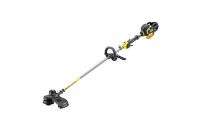
Lines and blades
There are two ways a grass trimmer can cut: with a nylon line or with a metal blade. A nylon line trimmer is usually called a grass trimmer, while a metal blade trimmer is called a brushcutter.
Line grass trimmer pros:
-
Cuts thin grass and weeds around edges and borders easily
-
Lightweight and easy to use
-
Some line grass trimmers use two lines to make trimming quicker
Line grass trimmer cons:
-
The nylon line is susceptible to breaking easily
-
Manually releasing new line from the reel can be fiddly and time-consuming (although some come with an auto-feed line for uninterrupted trimming)
-
Doesn’t cut thick vegetation
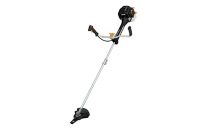
Blade brushcutter pros:
- More powerful than line grass trimmers
- Can cut through compact areas of thick vegetation
Blade brushcutter cons:
- Not as easy to use as a line grass trimmer as it requires a specific cutting technique to avoid the machine kicking back at you
- Requires more maintenance than a line grass trimmer to keep the blades sharp

Corded and cordless
Corded grass trimmers are plugged into the mains electricity.
Corded grass trimmer pros:
- Unlimited run time
- Easy to use
- Low maintenance
Corded grass trimmer cons:
- Limited by the length of the cable
- The cable can get in the way, and you must be careful not to cut through it
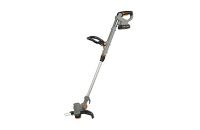
Cordless grass trimmers can be powered by a rechargeable lithium-ion battery or petrol.
Battery cordless grass trimmer pros:
- No trailing leads to worry about
- Quiet to operate
- Easy to start compared to petrol trimmers
- Ideal for large gardens or where there’s no access to an outdoor power source
Battery cordless grass trimmer cons:
- Limited by battery running time
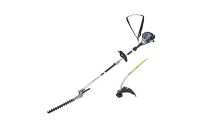
Petrol cordless grass trimmer pros:
- No trailing leads to worry about
- No restrictive cable
- More powerful than other types of grass trimmer
- Ideal for large gardens or where there’s no access to an outdoor power source
- Keeps going longer than battery-powered trimmers
Petrol cordless grass trimmer cons:
- Heavier than electric and battery powered trimmers
- Very noisy
- Ongoing fuel costs
- Needs regular maintenance and servicing
- Can be difficult to start (particularly models with a pull-cord start)
Produce smelly fumes and emit environment damaging CO2
What to Consider When Buying a Grass Trimmer
We’ve covered the most important information about grass trimmers above. But here are some other things to consider before you buy:
-
Cutting width - Grass trimmers are available in a variety of cutting widths. The wider the cutting width, the more grass and weeds it will get through in a faster time. But a wider cutting width isn’t always the best, as grass trimmers with small cutting widths are more able to get into tight areas. As a guide, a cutting width of 2-3cm is ideal for light grass and small to medium lawns. A 3-4cm cutting width is suitable for thick grass and medium to large lawns. And any cutting width above 4cm is best for thick grass and large gardens.
-
Weight and adjustability - If you’ll be using a grass trimmer for long periods, it’s essential to get one that’s comfortable and doesn’t put a strain on your back and muscles. First, think about the weight. Petrol grass trimmers tend to be the heaviest, so look for one with a second handle. Some heavy models also come with a strap to strap it over your shoulder. Next, think about the length of the pole. Some grass trimmers have telescopic handles that allow you to adjust the length to one that suits your height.
-
Flower guards - If you’re using a grass trimmer near flower beds, opt for one with a flower guard. This provides a barrier between the line or blade and the flowers to prevent them from getting cut.
-
Adjustable heads - Some grass trimmers have adjustable heads that can be swivelled at different angles. This can be useful if you need to trim in hard-to-reach areas. And they can also turn the grass trimmer into an edger to give the sides of the lawn a neat finish.
Hedge Trimmers Explained
Hedge trimmers are an essential piece of equipment for keeping hedges tidy. They consist of the main body, housing the engine, and a long set of metal blades with sharp teeth on either side. When the hedge trimmer is switched on, the metal blades move back and forth to create a cutting action.
Hedge trimmers are available in different power options:
Corded electric hedge trimmers are powered by a mains cable, so they need to be used where there’s a socket close by. They’re lightweight and easy to use. But the cable can be a hindrance while you’re working.
Petrol hedge trimmers can be used anywhere, and there’s no cable to accidentally cut through. They’re more powerful than electric hedge trimmers but are heavier and noisier. They also require more maintenance, incur ongoing fuel costs and emit CO2 gases.
Cordless electric hedge trimmers are powered by a rechargeable lithium-ion battery, which is an eco-friendly alternative to petrol hedge trimmers. They give you the same freedom as a petrol one but are lighter and quieter. The only limit on a cordless model is the battery running time, so we’d recommend buying a spare battery.
When buying a hedge trimmer, it’s important to consider how powerful it needs to be depending on the type of hedge you’re cutting. The power in electric hedge trimmers is measured in watts (w) and ranges from 400w to 900w. The power in a cordless battery powered model is measured in volts (v) and ranges from 18v to 36v. And petrol models are measured by their engine’s cubic capacity (cc), which tends to be around 22-26cc. Generally, the higher the wattage/volts/cubic capacity, the more powerful the hedge trimmer. A high-powered hedge trimmer will cut through tougher and thicker branches more easily and quickly than a low-powered one.
However, tooth opening - the space between the cutting teeth - is also a factor in how well a hedge trimmer will cut. Narrow tooth openings of around 15-20mm are fine for small, neat hedges. But for a hedge that’s more overgrown or that has thick branches, a tooth opening of 30mm, or more is ideal.
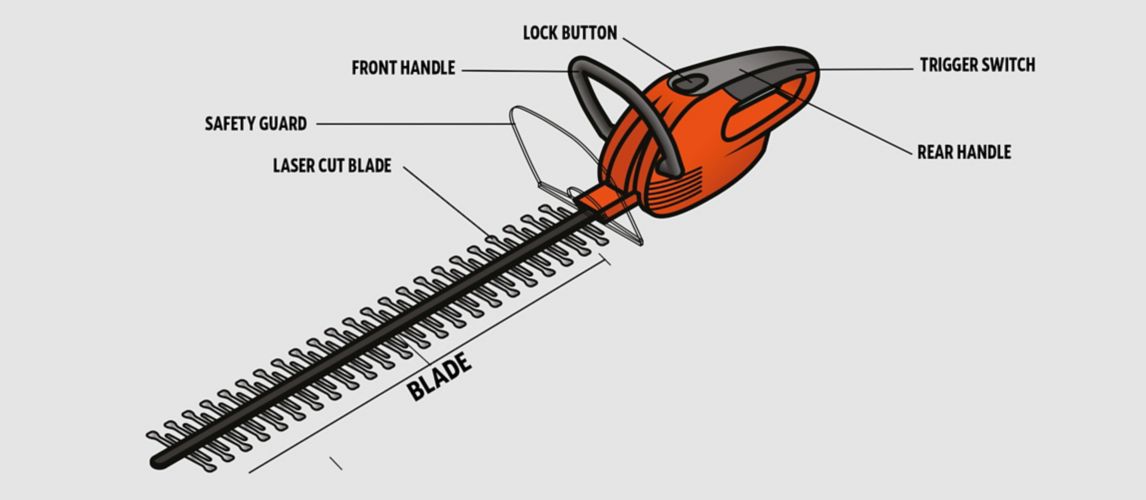
What to Consider When Buying a Hedge Trimmer
We’ve covered the most important information about hedge trimmers above. But here are some other things to consider before you buy:
-
Blade length - The length of blades on hedge trimmers varies significantly, with the shortest blades available being around 12cm and the longest being 75cm. The size you need will depend on the size of hedges it needs to cut. A short blade is fine for small hedges, while a long blade makes cutting a large hedge quick work. Also, if you can only access a hedge from one side, you’ll need to ensure the blade is long enough to cover its width so you can trim the top.
-
Safety features - Hedge trimmers can cause nasty injuries, so look for models with safety features, such as wrap around handles and a dual-safety switch that stops it from turning on accidentally.
-
Height - If you need to cut tall hedges, look for a long reach hedge trimmer. They’re designed to cut hedges high up, safely and easily, without the use of a ladder. They’re also useful for trimming shrubs and low hedges without the need to bend down.
-
Accessories - Some garden power tools have detachable heads and come with multiple tools that allow you to complete many garden maintenance tasks. They are called garden multi-tools. The extra tool heads they come with vary but can include hedge trimmers, grass trimmers, brush cutters and pole saws.
Maintenance, Cleaning and Storage
To get the best out of your garden power tools and extend their life, it’s important to keep them well maintained. Of course, every garden power tool is different, so always follow the manufacturer’s instructions. But here are a few general tips:
Lawn mowers:
- Clean grass out of the cutting area after each use
- Sharpen the blades after every 20-25 hours of use and replace them if they’re damaged
- Store it in a dry place, such as a garage or shed, and use a protective cover
Grass trimmers:
- Clean grass and any other debris out of the cutting area after each use
- On grass trimmers, inspect the nylon line and replace it if it’s damaged
- On brush cutters, sharpen the blade regularly
Hedge trimmers:
- Clean debris out of the cutting area after each use
- Sharpen the blades regularly
- Spray the blades with care oil or maintenance spray after every use
All petrol garden power tools:
Petrol garden power tools should be serviced annually by a garden machinery specialist, but you should also regularly:
- Check oil and fuel levels
- Lubricate the cables
- Clean the air filters
- Clean the spark plugs
- Clean the carburettor with a spray of WD-40. Remove obstructions with a carburettor cleaning brush and a spray of compressed air
- Don’t use fuel that’s more than 30 days old, and don’t leave petrol in the tank if the tool is going to be stored for 30 days or more
- For tools with an electric start engine, disconnect the batteries to the engine when storing over winter
